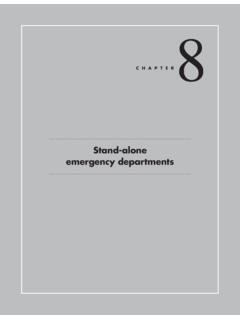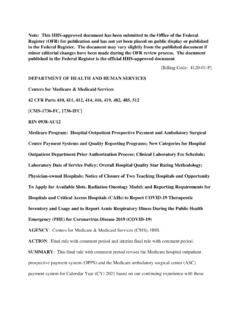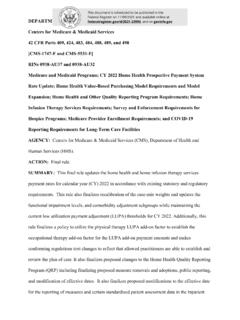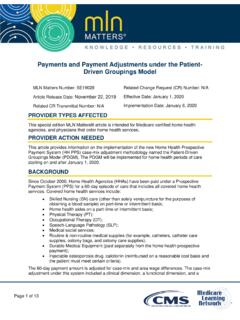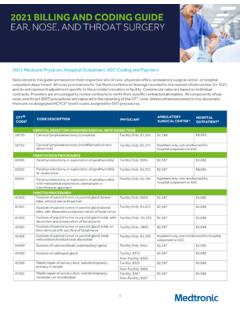Transcription of INPATIENT REHABILITATION FACILITIES paymentbasics …
1 INPATIENT REHABILITATION FACILITIES paymentbasics PAYMENT SYSTEM. Revised: After an illness, injury, or surgery care , is subject to Medicare's limits on INPATIENT October 2016 some patients need intensive INPATIENT hospital care ; thus beneficiaries' IRF stays REHABILITATION services, such as physical, are covered for 90 days of hospital care per occupational, or speech therapy. Such illness, with a 60-day lifetime services are frequently provided in skilled nursing FACILITIES (SNFs) but are sometimes Defining the INPATIENT REHABILITATION provided in INPATIENT REHABILITATION facility product Medicare buys FACILITIES (IRFs).
2 Comparatively few Medicare beneficiaries use IRFs, in part Since January 2002, Medicare has paid because nationwide there are fewer IRFs IRFs predetermined per discharge rates than SNFs but also because, to be eligible based primarily on the patient's condition for treatment in an IRF, the patient (diagnoses, functional and cognitive generally must be able to tolerate and statuses, and age) and market area wages. benefit from three hours of therapy per day. Under the IRF prospective payment system (PPS), Medicare's payment rates IRFs may be freestanding FACILITIES are intended to cover all operating and or specialized units within acute care capital costs that efficient FACILITIES are hospitals.
3 To qualify as an IRF, a facility expected to incur in furnishing intensive must meet Medicare's conditions of INPATIENT REHABILITATION services. participation for acute care hospitals. In addition, the facility must be primarily focused on treating one of 13 Setting the payment rates conditions that typically require intensive payments to IRFs are determined by REHABILITATION therapy (see the discussion adjusting a base payment rate for of the IRF compliance threshold below), geographic differences in labor costs and must meet other requirements, such as and for case mix.
4 The base payment having a medical director of REHABILITATION rate for each IRF discharge is based on who provides services in the facility on a the national average routine operating, full-time basis (or for at least 20 hours per ancillary, and capital costs in IRFs in week in hospital-based units). Medicare 1998, updated for inflation. The IRF base payments to IRFs totaled an estimated payment rate $15,708 for fiscal year $ billion in 2014. Medicare beneficiaries 2017 is adjusted for differences in labor account for about 60 percent of IRF cases.
5 Costs by multiplying the labor-related In 2014, there were about 375,000 fee-for- portion of the base payment amount 71. service Medicare cases, and 1,180 FACILITIES percent by a version of the hospital wage This document does not were Medicare certified. Freestanding index (Figure 1). reflect proposed legislation IRFs accounted for 48 percent of Medicare or regulatory actions. IRF discharges but just 21 percent of The wage-adjusted base rate is then FACILITIES . case-mix adjusted. Medicare patients are assigned to case-mix groups (CMGs).
6 Beneficiaries transferred to an IRF from based on the primary reason for intensive an acute care hospital pay no additional REHABILITATION care (for example, a stroke 425 I Street, NW deductible. However, beneficiaries or hip fracture), age, and level of motor and Suite 701 admitted from the community are cognitive function. Within each of these Washington, DC 20001 responsible for a deductible $1,288 in CMGs, patients are further categorized into ph: 202-220-3700 2016 as the first admission during a spell one of four tiers based on the presence of fax: 202-220-3759 of illness.
7 Beneficiaries are responsible for specific comorbidities that have been found a copayment $322 per day for the 61st to increase the cost of care . Each CMG. through 90th days. Coverage of IRF stays FIGURE. 1 Figure 1 InpatientInpatient REHABILITATION REHABILITATION facilitypayment facility prospective prospective systempayment system Policy adjustments High- Full If patient is Adjusted for Adjusted for for qualifying Payment cost geographic factors case mix FACILITIES LOS extraordinarily outlier costly Rural (payment Base rate location +.)
8 IRF 71% 29% adjusted Share of outlier adjusted + non-labor CMG payment). base for x low-income by area related weight rate geographic patients wages portion factors Teaching facility If Short- CMG LOS stay 3 days CMG*. Patient characteristics: Hospital Diagnosis requiring REHABILITATION wage Functional status index Cognitive status Age Comorbidities Note: IRF ( INPATIENT REHABILITATION facility), CMG (case-mix group), LOS (length of stay). *IRFs with a wage index of are paid $2,490 for short-stay cases in fiscal year 2017.
9 Tier has a specific weight that is used to facility's combined share of Medicare days adjust the base payment rate up or down, furnished to beneficiaries eligible for to reflect the costliness of patients in that Supplemental Security Income benefits CMG tier relative to the costliness of the and the share of all patient days furnished average Medicare IRF patient. Patients to Medicaid patients not covered by with a length of stay less than 4 days are assigned to a single CMG regardless of High-cost outliers The IRF PPS has diagnosis, age, level of function, or presence an outlier policy for cases that are of extraordinarily costly.
10 Medicare makes Payment rates are also adjusted to account outlier payments when an IRF's estimated for certain facility characteristics. Rural total costs for a case exceed a cost FACILITIES ' payment rates are increased by threshold. The outlier payment for a case percent because they tend to have is equal to 80 percent of costs above this fewer cases, longer lengths of stay, and threshold. The cost threshold is equal higher average costs per case. payments to the sum of the IRF's usual payment for IRFs that are teaching institutions for the case-mix group plus a fixed-loss are adjusted upward based on the ratio amount (For fiscal year 2017, the fixed- of residents to average daily census.)


